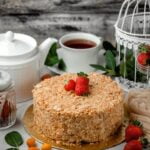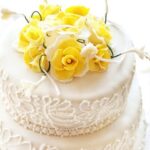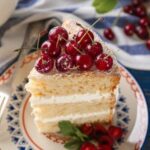Cake decorating is an art form that allows individuals to transform a simple cake into a stunning masterpiece. Whether it’s for a birthday, wedding, or any special occasion, taking the time to decorate a cake can make it truly memorable. For beginners looking to dip their toes into the world of cake decorating, this skill offers a fantastic starting point.
The beauty of cake decorating lies in its ability to combine creativity with deliciousness. The process of decorating a cake allows individuals to express themselves and create something unique and beautiful. From piping intricate designs to crafting delicate flowers, there are endless possibilities when it comes to creating stunning cake decorations.
Not only is cake decorating an enjoyable and creative hobby, but it also serves as an excellent skill for beginners to cultivate. Unlike some other forms of art, cake decorating doesn’t require extensive training or artistic talent. With patience and practice, anyone can learn the techniques needed to create visually appealing cakes.
By mastering the fundamentals of cake decorating, beginners establish a solid foundation for more advanced skills in the future. These skills include leveling and trimming a cake evenly, applying smooth crumb coatings and icing, piping intricate designs, and creating various frosting textures. Each step builds upon the previous one, equipping individuals with essential knowledge and techniques needed for more complex designs.
With each beautifully decorated cake, beginners gain confidence and experience that propels them further in their journey as skilled decorators. So why not pick up some tools and start exploring the world of cake decorating? It’s an art worth learning that lets your creativity shine while providing sweet treats for everyone to enjoy.
Essential Tools and Equipment for Cake Decorating
Cake decorating requires a few essential tools and equipment to help you create beautiful designs and achieve professional-looking results. Here is a comprehensive list of must-have tools for cake decorating:
- Cake Turntable: A cake turntable is an essential tool that allows you to easily rotate your cake while decorating. This makes it easier to reach all sides of the cake and create even designs.
- Spatulas: Spatulas come in different shapes and sizes, and they are used for a variety of tasks in cake decorating. Offset spatulas are perfect for smoothing icing, while straight spatulas are great for spreading and smoothing buttercream.
- Piping Bags: Piping bags are used for creating beautiful designs on cakes using various tips. They come in different materials, such as disposable plastic or reusable fabric, and they can be fitted with different types of piping tips.
- Piping Tips: Piping tips determine the shape and design of the decorations you pipe onto your cake. There are a wide variety of tips available, from round tips for writing or outlining to star tips for creating rosettes or stars.
- Bench Scraper: A bench scraper is a flat, rectangular tool with a straight edge. It’s used to smooth the sides of a cake, create sharp edges, and remove excess frosting or crumbs.
These are just a few examples of the essential tools that every beginner should have in their toolkit. When choosing these tools, it’s important to consider quality and durability. Look for tools that are comfortable to hold and easy to clean.
To find these tools, you can visit your local kitchen supply store or browse online retailers specializing in baking supplies. There are also specialized stores that cater specifically to cake decorators. Additionally, many craft stores carry basic supplies for cake decorating.
When starting out as a beginner in cake decorating, it’s advisable to invest in some basic tools and gradually build up your collection as you progress. Experimenting with different tools and techniques will help you discover your preferences and style as a cake decorator.
Basic Cake Decorating Techniques for Beginners
Step-by-Step Guide on How to Level and Trim a Cake
Leveling and trimming a cake is an important step in creating a professional-looking finished product. To start, ensure that your cake has completely cooled before handling it. Use a long serrated knife or cake leveler to remove any uneven or domed tops from the cake layers.
Begin by placing the cake on a flat surface and carefully slicing off the top to create an even surface. Be gentle and use slow, sawing motions to achieve an even cut. Repeat this process for each layer, if you are working with multiple layers.
Crumb Coating and Icing Techniques for a Smooth Finish
After you have leveled your cake layers, it’s time to crumb coat and ice your cake for a smooth finish. Crumb coating involves applying a thin layer of frosting over the entire cake to seal in any crumbs. This helps create a clean canvas for the final layer of icing.
To crumb coat, start by applying a thin layer of frosting onto the top of the first layer using an offset spatula. Spread it evenly across the surface, making sure to cover all areas. Repeat this process for each layer of cake.
Once you have completed the crumb coat, refrigerate the cake for about 30 minutes to allow the frosting to set. Afterward, apply another thicker layer of icing over the crumb coat using smooth strokes with your offset spatula. Continue spreading until you achieve an even and polished look.
Piping and Frosting Techniques for Different Designs
Piping and frosting techniques are essential skills in creating beautiful designs on cakes. Piping involves using various types of tips attached to piping bags filled with buttercream or royal icing to create patterns, shapes, borders, and more.
Start by selecting the appropriate piping tip for your desired design. Attach the tip to a piping bag and fill it with icing. Hold the piping bag at a 45-degree angle to the cake surface and gently squeeze to release the icing. Practice on a piece of parchment paper first to get comfortable with controlling the pressure and creating consistent shapes.
Whether you want to pipe rosettes, borders, or lettering, practicing different techniques is key. Remember to keep a steady hand and apply even pressure as you pipe. With time and practice, you will become more proficient in creating intricate designs that will impress your friends and family.
By learning these basic cake decorating techniques, beginners can gain confidence in their skills and create stunning cakes. With step-by-step guidance on leveling and trimming cakes, crumb coating, icing techniques, and piping designs, beginners can start their journey towards becoming skilled cake decorators. So roll up your sleeves, grab your tools, and let your creativity shine as you embark on this delicious art form.
Tips for Choosing the Right Cake Recipe
Choosing the right cake recipe is essential for beginners in cake decorating. A well-chosen recipe can make the process easier and more enjoyable, while also ensuring a delicious end result. Here are some tips to help beginners select the perfect cake recipe:
- Consider the Level of Difficulty: When choosing a cake recipe as a beginner, it’s important to start with something that matches your skill level. Look for recipes labeled as “beginner-friendly” or “easy” to avoid unnecessary frustration. As you gain more experience, you can gradually try more complex recipes.
- Focus on Flavor: The flavor of the cake is an important aspect of any successful cake decoration project. Consider your personal preferences and those of your intended audience when selecting a flavor. Some popular options for beginners include vanilla, chocolate, and lemon cakes.
- Pay Attention to Texture: Different cakes have different textures, which can affect their suitability for certain decorating techniques. For example, dense cakes like pound cakes may be better suited for carving detailed shapes, while lighter sponges may be easier to layer and crumb coat. Think about the desired texture of your finished creation and choose a recipe accordingly.
- Testimonials and Reviews: Before committing to a specific recipe, take some time to research online reviews or ask for recommendations from experienced bakers. Hearing about other people’s experiences with a particular recipe can give you valuable insights into its difficulty level and taste.
By considering these tips when choosing a cake recipe, beginners in cake decorating can set themselves up for success right from the start. Remember that practice makes perfect, so don’t be discouraged if your first attempts aren’t flawless. Enjoy the learning process and have fun experimenting with different flavors and designs.
| Tips for Choosing the Right Cake Recipe |
|---|
| Consider the Level of Difficulty |
| Focus on Flavor |
| Pay Attention to Texture |
| Testimonials and Reviews |
Understanding and Working with Different Types of Frosting
Overview of Different Types of Frosting
When it comes to cake decorating, understanding and working with different types of frosting is essential. Frosting not only adds flavor to a cake but also serves as the canvas for creative designs. There are several types of frosting to choose from, each with its own unique characteristics and uses.
One popular type of frosting is buttercream, which is made by combining butter, powdered sugar, and flavorings. Buttercream is known for its creamy texture and versatility, making it ideal for various cake designs. Another common type is ganache, which is made by melting chocolate together with heavy cream. Ganache creates a smooth and glossy finish that is perfect for elegant cakes.
Fondant is another popular choice for cake decorators. It is a pliable icing that can be rolled out like dough and draped over cakes for a polished look. Fondant allows for intricate details and can be molded into shapes and figures. Cream cheese frosting, on the other hand, adds tanginess to cakes and pairs well with fruity flavors.
Pro Tips on Creating the Right Consistency
Creating the right consistency for your frosting is crucial in achieving a smooth application on your cakes. Different designs require different consistencies, so it’s important to know how to adjust your frosting accordingly.
One way to achieve the desired consistency of buttercream frosting is by adjusting the ratio of butter to powdered sugar. Adding more powdered sugar will thicken the consistency, making it easier for piping intricate designs. On the other hand, adding a small amount of liquid such as milk or heavy cream can make the frosting smoother and easier to spread.
For ganache frosting, achieving the right consistency involves finding the ideal ratio between chocolate and cream. Adding more cream will result in a thinner ganache that can be poured over cakes smoothly. Conversely, increasing the amount of chocolate will thicken the ganache, making it suitable for piping or sculpting.
When working with fondant, keeping it at the right consistency is essential for easy handling. If the fondant becomes too dry and stiff, kneading in small amounts of shortening can help soften it. On the other hand, if the fondant becomes too sticky, lightly dusting your hands and surface with powdered sugar can prevent sticking.
Understanding how to create the right consistency for your frosting will greatly enhance your cake decorating skills. Practice and experimentation will allow you to find your own preferences and achieve professional-looking results.
Working with different types of frosting opens up endless possibilities in cake decorating. Whether you prefer the creamy texture of buttercream or the smooth elegance of ganache, understanding their characteristics and how to work with them is essential for creating beautiful cakes.
Adjusting the consistency of your frosting is a skill that takes practice but will ultimately elevate your designs to a whole new level. So don’t be afraid to experiment, try different combinations, and let your creativity shine through the art of frosting.
Beginner-friendly Cake Decoration Ideas and Designs
When it comes to cake decorating, there are endless possibilities for creative designs. However, as a beginner, it can be overwhelming to know where to start. In this section, we will explore some beginner-friendly cake decoration ideas and designs that you can try.
- Basic Shapes: One of the easiest ways to decorate a cake is by using basic shapes such as circles, squares, or triangles. You can use fondant or buttercream to create these shapes and arrange them in a pattern on the cake. Simple yet visually appealing, this technique is perfect for beginners who are just starting out.
- Borders: Adding borders to your cakes can instantly elevate their appearance. A classic border design is the shell border, which involves creating small overlapping shells around the edges of the cake. Another popular border design is the rope border, which resembles twisted ropes along the sides of the cake. These borders can be made using buttercream frosting with a piping bag and tip.
- Flowers: Creating flowers from icing or fondant is a great way to add elegance and beauty to your cakes. There are many different techniques for making flowers, including piping petals with buttercream frosting or shaping fondant into intricate floral designs. Start with simple flowers like daisies or roses and gradually work your way up to more complex blooms.
| Tools and Materials | Description |
|---|---|
| Piping Bags | Used for applying frosting or icing in various designs. |
| Piping Tips | Come in different shapes and sizes for different designs. |
| Fondant | A pliable icing used for creating decorative elements. |
| Gel Food Coloring | Used to add vibrant colors to frosting or fondant. |
| Offset Spatula | Helps in spreading and smoothing frosting on the cake. |
As you gain more experience and confidence, don’t be afraid to experiment with different techniques and designs. Remember, practice makes perfect, so keep practicing and exploring your creativity. The world of cake decorating is full of endless possibilities, and with dedication and passion, you can become a skilled cake decorator in no time.
Troubleshooting Common Cake Decorating Mistakes
Decorating a cake can be a fun and rewarding experience, but it’s not without its challenges. As a beginner, it’s common to encounter some common cake decorating mistakes along the way. However, with a little know-how and some handy tips and tricks, you can easily troubleshoot these issues and achieve professional-looking results.
One common mistake beginners make is uneven frosting or icing application. This can result in an unbalanced look and affect the overall appearance of your cake. To fix this, start by making sure your cake is level and evenly trimmed before applying the frosting or icing.
Use a long serrated knife or cake leveler to trim off any domed top or uneven edges. Once your cake is level, apply a thin layer of crumb coat-a thin layer of frosting that helps trap any loose crumbs-and let it set for about 15 minutes before applying the final layer of frosting.
Another common mistake is having air bubbles in your frosting or icing when piping designs onto the cake. To avoid this issue, make sure to properly mix your frosting before using it. Use an electric mixer on low speed to gently beat out any air bubbles that may have formed during the mixing process.
Additionally, tap the bowl on the counter a few times to release any trapped air bubbles. If you still notice air bubbles while piping, gently tap the piping bag against the counter to release them before continuing.
Lastly, overmixing your cake batter can lead to dense and tough cakes-which are not ideal for decorating. To avoid this mistake, follow the recipe instructions carefully and mix just until all the ingredients are incorporated. Overmixing causes gluten development in the batter, resulting in denser cakes. Be mindful of mixing times and use a gentle folding motion when incorporating dry ingredients into wet ingredients.
By being aware of these common mistakes and knowing how to fix them, you’ll be well on your way to achieving beautiful cake decorations. Remember, practice makes perfect, so don’t be discouraged if you encounter some mishaps along the way. With time and experience, you’ll become more skillful and confident in your cake decorating abilities.
Taking Your Cake Decorating Skills to the Next Level
Once you have mastered the basic techniques of cake decorating, you may find yourself eager to take your skills to the next level and create more intricate and professional-looking designs. Luckily, there are many resources available for further learning and improvement in cake decoration.
One option is to enroll in online courses specifically designed to help beginners progress in their cake decorating journey. These courses often offer in-depth tutorials, step-by-step instructions, and valuable tips from experienced decorators. They cover a wide range of topics, such as advanced piping techniques, intricate fondant designs, sculpting edible figurines, and more. Online courses allow you to learn at your own pace and provide a supportive community where you can connect with fellow hobbyists and professionals.
Another way to enhance your cake decorating skills is through practice and experimentation. Try challenging yourself by attempting more complex designs or experimenting with different techniques. Don’t be afraid to make mistakes along the way; they are part of the learning process. Take note of what works well and what doesn’t, allowing yourself room for improvement.
In addition to online courses and practice, seeking inspiration from professional cake decorators can help elevate your skills. Follow skilled decorators on social media platforms like Instagram or Pinterest to see their latest creations and get ideas for your own designs. Analyze their techniques, color combinations, and attention to detail. You can also attend cake decorating workshops or conventions where experts share their knowledge and showcase their creations.
Remember that becoming a skilled cake decorator takes time and patience. It’s important not to compare yourself too harshly with others but rather focus on your own progress. With dedication and a willingness to learn, you’ll be amazed at how far you can go in mastering this artistic skill.
Conclusion
In conclusion, learning how to cake decorate is a truly rewarding journey for beginners. Throughout this article, we have explored the beauty of cake decorating and why it is a great skill for novices to start with. We have also discussed the essential tools and equipment needed for cake decorating, as well as basic techniques and tips for choosing the right cake recipe and working with different types of frosting.
As beginners, it’s important to remember that practice makes perfect. By following the step-by-step guides and beginner-friendly designs provided in this article, you can gradually develop your cake decorating skills. Mistakes are bound to happen along the way, but don’t let them discourage you. Instead, view them as opportunities to learn and improve.
To further enhance your knowledge and technique in cake decorating, there are various resources and online courses available for further learning. These will enable you to take your skills to the next level and create even more impressive designs. Whether it’s mastering advanced piping techniques or creating elaborate fondant decorations, there are endless possibilities for you to explore.
Frequently Asked Questions
What is the easiest way to decorate a cake?
The easiest way to decorate a cake is by using pre-made decorations such as edible cake toppers or fondant cutouts. These can be easily purchased from baking supply stores or online, and they are ready to use straight out of the package.
Simply place them on top of the cake or arrange them creatively around the edges for an instant decoration. This method requires minimal skill or experience in cake decorating and allows for quick and effortless results.
What does a beginner need for cake decorating?
For a beginner in cake decorating, there are a few essential items that are needed. Firstly, a basic set of icing tips and piping bags will be necessary to create different designs on the cake. These can be easily found in baking supply stores and come in various sizes and shapes for different effects.
Secondly, an offset spatula will be useful for spreading frosting smoothly over the cake’s surface. It helps achieve an even layer of icing without messing up previous decoration efforts. Lastly, food coloring gels are handy for adding vibrant colors to icing and creating visually appealing designs.
What is the first step in decorating a cake?
The first step in decorating a cake is preparing it for decoration by ensuring it has cooled completely. Once baked, the cake needs to cool down entirely before any frosting or decorations can be applied; otherwise, they may melt or get ruined. After cooling, the next step involves leveling the tops of the cake layers if they have domed during baking.
This can be done using a serrated knife or a specialized leveler tool to trim off any unevenness and create flat surfaces for stacking layers later on. By starting with a perfectly cooled and leveled cake, you set yourself up for success in achieving an evenly decorated final product.

Welcome to my blog about home and family. This blog is a place where I will share my thoughts, ideas, and experiences related to these important topics. I am a stay-at-home mom with two young children. I hope you enjoy reading it! and may find some helpful tips and ideas that will make your home and family life even better!





